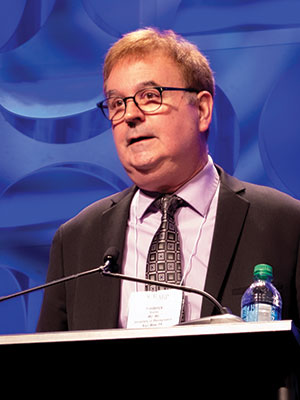
Once thought to be extremely rare, research over the past 20 years has shown that Sjögren’s syndrome is much more common than previously thought. Diagnosing the disorder, however, remains somewhat challenging, according to Frederick Vivino, MD, MS, FACR, who discussed “Pearls and Perils in the Diagnosis and Management of Sjögren’s Syndrome” during Saturday’s ACR Review Course. Dr. Vivino is Director of the Penn Sjögren’s Syndrome Center and Chief of Rheumatology at Penn Presbyterian Medical Center and Professor of Clinical Medicine at the University of Pennsylvania Perelman School of Medicine.
“For many years after it was first described in the 1930s, Sjögren’s was considered to be extremely rare and was actually listed in the registry of National Organization of Rare Diseases,” Dr. Vivino said. “In recent years, however, the pendulum regarding Sjögren’s prevalence has actually swung in the opposite direction, and we now view it as common.”
That change, he said, began in the late 1990s with the publication of a seminal study in Europe suggesting that as much as 3% to 4% of the British population had the disease. That was followed shortly by work from the Women’s Health Study and the Physicians Health Study that reported that as many as 20 million Americans may have dry eyes, including about 4.5 million people over the age of 50 with “clinically significant” dry eye, many of whom were assumed to have Sjögren’s syndrome.
“Then, in an epidemiologic study published in 2008 on the prevalence of various rheumatic diseases, Sjögren’s was listed second among all of the chronic autoimmune rheumatic diseases, second only to rheumatoid arthritis (RA) in prevalence,” Dr. Vivino said. “Interestingly, that study reported a very wide range of estimated prevalence, between 400,000 and 3.1 million people, which reflects in part the great challenge we still have in diagnosing it.”
True to the initial description of the disease nearly 90 years ago, Dr. Vivino said that approximately 80 percent of the overall group of people ultimately diagnosed with Sjögren’s syndrome present with some form of a sicca syndrome, i.e. dryness of the eyes, mouth, and other body parts that evolves over months or even years.
“It’s the remaining 20 percent that are even more interesting, because they present with internal organ or extra-glandular manifestations of the disease as the predominant manifestation,” Dr. Vivino said. “What’s particularly fascinating about this group is that, at the time they come to medical attention, they are typically not dry, so you could easily miss the diagnosis. This is particularly true for neurological Sjögren’s, which can present as demyelinating disease or peripheral neuropathy.”
Dr. Vivino said that it has been well established in both ophthalmology and rheumatology literature that the correlation between the severity of sicca symptoms and the results of objective tests for Sjögren’s syndrome is actually pretty poor. Conversely, he noted that many patients who complain the most about their sicca symptoms, when they undergo a thorough evaluation, will sometimes turn out to have something else as the cause of their symptoms
“That is because the list of differential diagnoses that cause sicca is quite long and still growing, the most common still being medication-induced dryness of both the eyes and the mouth, and the two latest additions to this list are dysautonomia and IgG4 syndrome,” Dr. Vivino said. “For that reason, in the appropriate clinical situation, regardless of whether or not the patient is dry, we recommend doing a comprehensive systematic valuation with three goals in mind — number one, to demonstrate objective evidence of dry eyes; number two, to demonstrate objective evidence of salivary gland involvement; and number three, proof of autoimmunity.”
